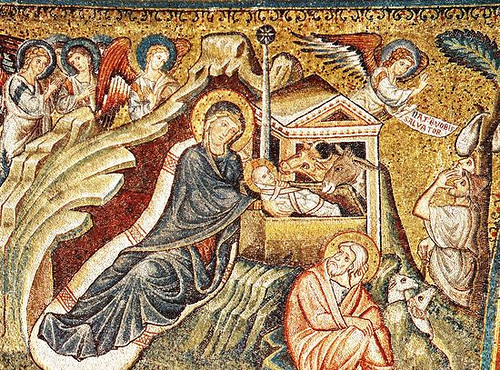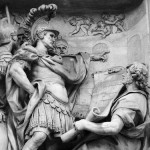We run our website the way we wished the whole internet worked: we provide high quality original content with no ads. We are funded solely by your direct support. Please consider supporting this project.

The Cross in the Manger
There has been a strand within the Western theological tradition—one that is especially prevalent in contemporary American Evangelicalism—that construes the significance of the cross in strictly soteriological terms. The cross is central, in this view, but only in the sense that the reason Jesus came to earth was to pay the price for our sin by dying, thereby allowing God the Father to vent his wrath on him in our place. This myopic focus, combined with this “penal substitutionary” understanding of the atonement, tends to relegate everything else Jesus said and did leading up to his passion to a secondary status. Hence, far from providing the thematic center of Jesus’ identity and mission, this perspective tends to divorce the cross from every other aspect of Jesus’ identity and mission.
The union of God and man in Jesus is “one dynamic event from the incarnation to ascension,” as T. F. Torrance wrote. God did not unite himself to a man and then, as a secondary thing, act. Instead, in Jesus, his personhood, his words and his acts are inseparable.
If this is true, then we can never separate who Jesus is as the God-man from what he did. We can also no more separate Jesus’ atoning work on the cross from the Incarnation and/or any other aspect of his life and ministry. Torrance writes, “we must think of [Christ’s] incarnate life and his redeeming activity as completely interwoven from his conception and birth to his crucifixion and resurrection.” And again, “Incarnation and atonement intrinsically locked into one another constitute the one continuous movement of God’s saving love for the world.”
Moltmann makes a similar point, when he asserts:
The incarnation of the Logos is completed on the cross. Jesus is born to face his passion. His mission is fulfilled once he has been abandoned on the cross. So it is impossible to speak of an incarnation of God without keeping this conclusion in view. There can be no theology of the incarnation which does not become a theology of the cross. As soon as you say “incarnation,” you say “cross.”
We cannot separate his death out from his life. The cross is the quintessential expression of who Jesus was and everything he was about. The indivisible and perfectly integrated wholeness of the one in whom God became human is oriented, from manger to ascension, around the cross. We could say the same thing by claiming that Jesus’ mission centered on sacrificially reconciling humanity to God, or by claiming that Jesus’ mission centered on revealing God’s true, self-sacrificial, loving nature to humanity. The atonement and revelation are two sides of the same coin. God reconciles humanity to himself by revealing his true loving character, and God reveals his true loving character by reconciling humanity to himself. And this revelation-that-is-reconciliation and reconciliation-that-is-revelation takes place in the Word made flesh, understood as “one dynamic event from incarnation to ascension”.
If it is the whole unity of the person and work of Jesus that reveals God to us, then this unity must be centered on the love of God that was supremely revealed on the cross. Hence, while the common, myopic, Evangelical understanding of the cross tends to isolate the cross from other aspects of Jesus’ identity and mission, this view centralizes the cross as the thread that weaves together every aspect of Jesus’ life, from the incarnation first displayed in the manger to his ascension.
Photo Credit: jimforest via Flickr
Category: General
Tags: Christmas, Cross, Incarnation, Jesus, Jürgen Moltmann, T. F. Torrance
Topics: Christology
Related Reading

Greg and N.T. Wright at the Missio Alliance Gathering!
The Missio Alliance North American Gathering will be held April 27-29 in Alexandria, Virginia. The theme this year is Awakenings: The Mission of the Spirit as the Life of the Church. Featured speakers this year include Jorge Acevedo, Greg Boyd, Ruth Padilla Deborst, Tammy Dunahoo, Todd Hunter, Dr. Charles A. Montgomery, Jr., Cherith Nordling, Rev. Dr. Howard-John…

Simple Holidays
Lawrence OP via Compfight Here’s a reflection from Joshua Becker on Keeping the Main Thing the Main Thing During the Holidays. From the article: Surely, each of us will define our holiday most important differently. Many will seek spiritual renewal. Some will celebrate family. Some will refocus on giving to others. Some will seek rest. Some will…

The Cruciform Center Part 2: How John’s Gospel Reveals a Cruciform God
In the previous post, we looked at how the Synoptics illustrate the centrality of the cross. While the Gospel of John varies in its structure and language from the Synoptics, the cross remains at the center. This centrality is expressed in a number of different ways. 1. The role that Jesus’ death plays in glorifying…

Why Didn’t Jesus Denounce Military Service?
A common objection to the claim that Jesus and the authors of the New Testament were opposed to all forms of violence is that neither Jesus nor anyone else speaks out against it. When soldiers asked John the Baptist what they should do in response to his message, for example, he told them not to…

Drum Roll Please: Greg’s Final Critique of Bart Ehrman’s Article
This is the ninth and final of several videos Greg put together to refute Bart Ehrman’s claims published in the article What Do We Really Know About Jesus? Thanks for hanging in there for this last one. I know it was a long wait, but the holidays got inordinately busy for Greg. In this segment, Greg talks…
